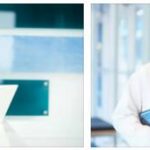Doctors speak of a pathological curvature of the spine when its curvature exceeds the normal degree. The curvature of the spine occurs as a hunchback, hollow back or scoliosis. The therapy is carried out with physiotherapy, aids to support the back or operatively and has very good chances of recovery in childhood.
What is a spinal curvature?
A spinal curvature occurs when the curvature of the spine is not normal. It is important to know that the healthy spine has two curvatures: lordosis and kyphosis. For definitions of hypodontia, please visit topbbacolleges.com.
Kyphosis is the backward tilt of the spine in the thoracic area, lordosis is the bending of the cervical and lumbar spine. If the lumbar and/or cervical spine is excessively curved backwards, the affected person has a hollow back.
If the thoracic spine is bent forward too much, the result is a hunchback. Both diagnoses are more likely to be seen as symptoms of incorrect posture or lack of exercise than as diseases in their own right. As a rule, no changes or damage can initially be detected in the spine.
Another form of spinal curvature is scoliosis, in which there is a lateral bending of the spine with twisting of the vertebrae against each other. This disease occurs in about two to three percent of the population, with more girls than boys being affected.
Causes
The causes of spinal curvature are often incorrect posture and insufficient movement and the associated insufficiently trained abdominal and back muscles.
Excessive backward stretching of the spine, as occurs in some sports, can induce a spinal curvature in the form of hunchback if the disposition is present.
Other causes of hunchback are genetics, bone disease, osteoporosis and age-related disc wear. Scoliosis is a special case of spinal curvature for which no known causes are known. The research assumes a misdirected trunk musculature with staggered growth of the vertebral bodies as the trigger of the problem.
As a result, there appears to be rotation of individual vertebrae and then twisting and lateral bending of the entire spine. Bone diseases, a pelvic obliquity due to unequal leg lengths, muscular or neurological complaints can rarely be identified as causes of scoliosis.
Symptoms, Ailments & Signs
A curvature of the spine usually remains symptom-free at first. Those affected perceive them only as an optical flaw, which is why shame sets in in swimming pools or on beaches. With increasing age, however, if there is no treatment, further negative side effects occur. These show up primarily in back pain.
Other organs can also be affected by the malformation. A curvature in the back is regularly associated with muscle tension. Signs of wear and tear, which are only to be expected with age, then appear much earlier. The back hurts regularly, even when there is no stress. Visually, many postural defects are possible.
In some patients, the center of the pelvis is to the right or left of the center of the head. There is also the possibility that the pelvis is crooked. Sometimes one shoulder protrudes more prominently than the other. The typical S-shape of the spine is no longer present. The ventral part of the spine often shows stronger growth than usual.
The curvature of the spine can affect the entire musculoskeletal system. The feet and knees also suffer from the deformity. In rare cases, severe deformation has consequences for the internal organs. The heart, kidneys and lungs then show functional disorders.
Diagnosis & History
The curvature of the spine is determined on the basis of a physical examination and postural diagnostics. An X-ray is usually also taken to diagnose the shape and severity of the curvature of the spine. In the case of scoliosis, suitable therapeutic measures can also be determined by means of an X-ray.
If the patient suffers from scoliosis, changes in the spine can be seen and felt. If the scoliosis affects the lumbar spine, the formation of the waist, for example, is conspicuous, with a curvature of the thoracic spine, the ribs protrude on one side.
The Matthias posture test is used to diagnose poor posture. The examinee must stand up straight, close their eyes and keep their arms stretched out in front of them for thirty seconds. If the muscles are working properly, the patient can maintain the position they have taken for the entire duration. Muscle weakness shows up accordingly.
Complications
A spinal curvature can result in various complications. Whether and which side effects occur depends on the causes of the scoliosis, the time of diagnosis and the age of the patient. Complications threaten primarily with a long-term curvature of the spine.
A long-lasting misalignment can lead to signs of wear and tear on the spine or the intervertebral discs. In most cases, these are accompanied by severe pain. In addition, there is a risk of a herniated disc or an increasing stiffening of the spine. Other joints such as the hips or knees can also be affected due to illness.
Some people suffer from discomfort in the chest or abdominal region due to a curvature of the spine and the associated shortening of the trunk. For example, there is sometimes a reduction in the size of the chest and abdomen, which in turn has a negative effect on organ functions. The heart, lungs, intestines and kidneys are most commonly affected. Severe scoliosis can even endanger life, such as heart failure, if there is a severe functional impairment of the organs.
There is also a risk of complications with surgery to treat a spinal curvature. However, the danger rate is considered to be low and is less than five percent. Possible consequences of a scoliosis operation are pseudarthrosis, metal fractures including loss of correction, spinal cord injuries, partial or complete paraplegia and infections that require the removal of the implant.
When should you go to the doctor?
If there are any abnormalities in the child’s body structure during the course of growth and development, these should be observed. In the case of a curvature of the spine, the child must be informed about the correctness of physical stress and general movement sequences. Regular corrections should be carried out in everyday life so that long-term damage can be prevented. If the curvature of the spine can no longer be changed through independent measures or if it takes on a permanent form, a doctor should be consulted.
If the body develops incorrect posture, muscle complaints and limitations in physical resilience, a doctor’s visit is necessary. Pain in the back, irregularities in general locomotion, unsteady gait or headaches indicate a health problem. A doctor’s visit is necessary so that the cause can be clarified and targeted therapies can then be carried out to alleviate the symptoms. If there are general functional disorders, changes in the heart rhythm or a misalignment of the feet or knees, a doctor’s visit is also necessary.
Breathing problems, disorders of the digestive tract and a diffuse pain experience in the organism indicate organic impairments. A doctor must be consulted so that the cause can be clarified. If sports activities can no longer be carried out without symptoms or if the person concerned has problems coping with everyday life, he needs a doctor.
Treatment & Therapy
Posture-related curvatures of the spine are treated with physiotherapy and movement therapy. The abdominal and core muscles in particular need to be trained, since strong core muscles stabilize the spine. However, the patient must not train too much, only a slow build-up of muscles promises to improve the symptoms.
The therapy of scoliosis is more difficult. This is based on a timely diagnosis, ideally during puberty. Only during this time can growth be positively influenced with conservative and operational measures. Before the therapy, the severity of the spinal curvature is defined and the therapy is based on this:
A curvature angle below 20 degrees is observed while trying to promote a healthy posture with physiotherapy measures. With an angle between 20 and 40 degrees, a corset is additionally prescribed, which must be worn daily for two to three years. With a scoliosis angle of more than 40 degrees, vertebral segments are surgically stiffened to stop the progression of the disease.
Prevention
Functional curvature of the spine can be prevented by targeted training of the trunk muscles and sufficient exercise. There is no way to counteract scoliosis.
Aftercare
Follow-up treatment is particularly important if the spinal curvature or scoliosis has been treated surgically. After the procedure, the patient is transferred from the intensive care unit to the normal ward of the hospital after a day or two. As a rule, the patient is then gradually allowed to leave the bed again.
Follow-up treatment begins early with daily physiotherapy exercises. However, the extent of the operation must be considered when considering the scope of the physiotherapy. For the pain that occurs after the surgical procedure, the patient is often given opiates or opioids.
If it is a minor surgical treatment, a weaker-acting opioid such as tramadol is usually administered. If the pain is more pronounced, stronger analgesics such as piritramide or morphine can also be given.
It usually takes 12 to 14 days for the patient to be able to leave the hospital after the operation. Healing progresses faster the younger the patient is. It usually takes six to nine months for the spine to ossify. During this period, the patient is not allowed to do any sports for the first six months. An exception is medical training therapy (MTT).
Regular check-ups are also an important part of aftercare. It takes about three to six months to complete medical rehabilitation. Children and young people often do not need rehabilitation at all.
You can do that yourself
In the case of a spinal curvature, the physical strain must be adapted to the health possibilities. Overexertion of any kind should be avoided. Lifting and carrying heavy loads is not permitted. In addition, the correct movement sequences in everyday life should be trained and optimized. In this way, the fulfillment of everyday tasks can take place better.
Maintaining a healthy posture should be independently checked several times during the course of the day so that the symptoms do not increase. At the same time, it is important not to trigger any secondary diseases as a result of persistent poor posture. One-sided movements and rigid postures should be avoided and balancing movements should be carried out regularly. Physical therapy exercises can help improve overall health. These should also be used outside of therapy. Sports activities must be tailored to the needs of the organism. The musculature as a whole must be protected from hardening. Massages, warm clothing, avoidance of drafts and stimulation of the blood circulation are helpful for this.
In the case of severe curvature, walking aids have proven to be effective. These can lead to a straightening of the gait and protect against a deterioration in health. You should also check your sleep hygiene. The mattress should not show any damage and its degree of firmness should be optimized. In some cases, the settings of the slatted frame need to be improved so that an optimal sleep can take place.








